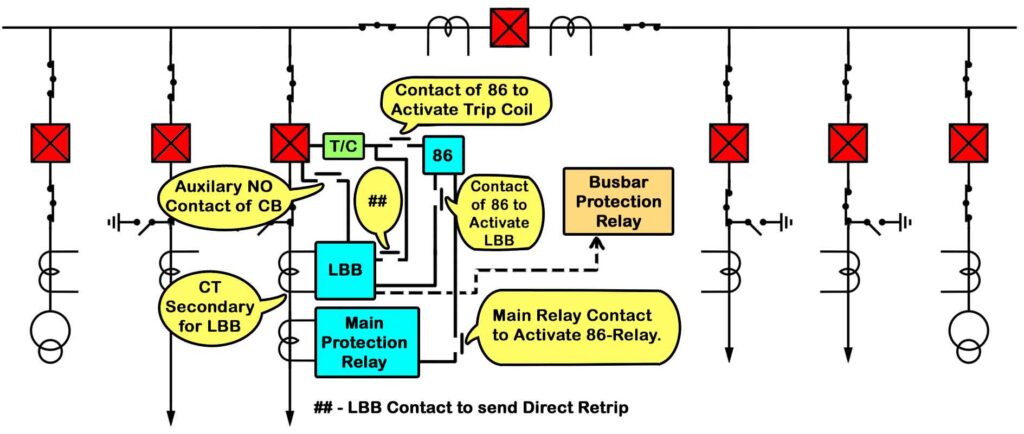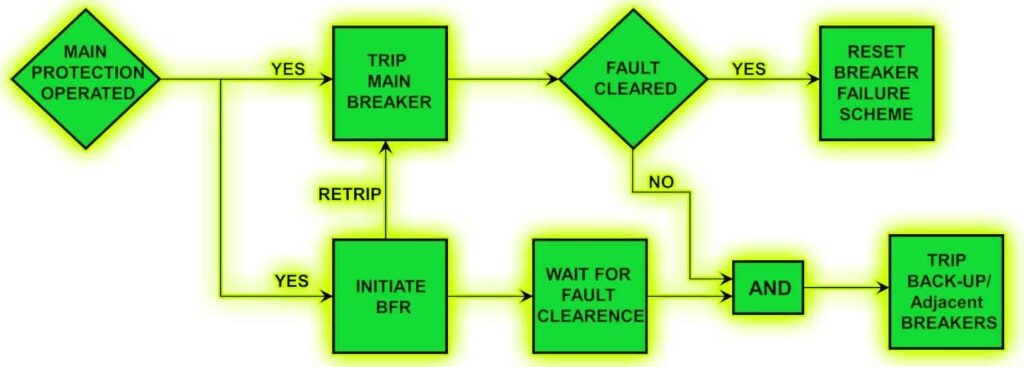What is LBB Protection?
Local Breaker Backup (LBB) Protection is a special protection scheme. This protection isolates a fault from the electrical power system when a circuit breaker fails to do so. When a fault occurs at a particular point in a power system, the primary protection relay associated with that part of the system detects the fault. Then the primary relay activates the master trip relay (86). The activated master trip relay sends the trip signal to the associated circuit breaker. Then the breaker breaks the circuit and clears the fault.
There may be a situation when, due to mechanical, electrical, or control circuit failure, the circuit breaker cannot open. In that case, LBB comes into the picture. The local breaker backup (LBB) relay sends trip signals to the adjacent or upstream breakers. Therefore, all these breakers trip together to isolate the fault from the system. This ensures the reliability of the protection system even during the main circuit breaker failure. This is why we refer to this as Local Breaker Backup Protection.
Definition of LBB
Local Breaker Backup Protection is a special type of protection scheme that isolates a fault by tripping adjacent or upstream breakers. These breakers are associated with the faulty zone and operate when the main breaker fails.
Importance of LBB
When a fault occurs at any point in a power system, a large short circuit current starts flowing through the system. If this fault is not cleared within an acceptable time limit, it generates excessive heat. This heat can cause permanent damage to the system.
To avoid such situations, a circuit breaker must trip to interrupt the fault current. However, since the circuit breaker is an electromechanical device, there is always a possibility of failure to operate during a fault.
Causes of Circuit Breaker Failure
Several factors may prevent a circuit breaker from opening:
- Mechanical Failure: Sticking or jamming may occur in the movable parts of the breaker mechanism. This often happens due to lack of lubrication, aging, or other mechanical issues. As a result, the circuit breaker cannot open even after receiving an electrical pulse.
- Trip Coil Failure: The trip coil may become defective due to overheating. If damaged, it cannot initiate the tripping operation.
- Control Circuit Faults: Loose connections or breaks in the control wiring can prevent the breaker from operating.
- SF6 Lockout: In SF6 circuit breakers, gas lockout conditions can block operation.
- DC Supply Failure: If the DC supply in the protection trip circuit fails, the breaker will not open during a fault.
- Relay Malfunction: The 86 relay may fail to send the correct trip signal to the breaker due to internal defects.
Basic Operating Principle of LBB Protection
When a fault occurs, the primary protection relay, such as a distance relay, differential relay, or overcurrent relay, detects it. The relay sends a signal to the 86 Master Trip Relay.
During a fault, the secondary current of the current transformer (CT) exceeds a preset value. The protection relay senses this overcurrent condition and closes its contact. This activates the associated 86 relay.
The 86 relay is an instantaneous relay. It closes the normally open (NO) contact in the trip circuit. As a result, the DC voltage reaches the trip coil, and the breaker opens.
At the same time, another contact of the 86 relay, which also closes during its activation, triggers the LBB relay. The LBB relay, connected to the same CT secondary circuit, receives the same high current signal.
At this point, the LBB relay receives two signals:
- One from the 86 relay, indicating the trip command.
- Another from the CT secondary, indicating the fault current.
Now, the LBB relay needs a third input, and, this is the status of the breaker. A NO (Normally Open ) contact of the auxiliary switch of the breaker connected to the LBB relay provides this information.
If the breaker opens and clears the fault, the LBB relay detects the change in auxiliary contact status of CB, and receives no current in the secondary. It then resets its timer and deactivates the LBB.
If the breaker fails to open, the LBB relay continues receiving:
- High CT current
- A closed signal from the auxiliary contact of the CB.
As a result, the LBB timer continues. Normally, this timer is set to 200 milliseconds. If the breaker remains closed after this 200-millisecond period, the LBB sends a trip signal to adjacent or upstream breakers to clear the fault.

Single-Stage LBB
The scheme described above is a single-stage LBB. When a fault occurs, the LBB starts its timer. If the breaker does not clear the fault within the preset 200 milliseconds, the LBB trips all associated circuit breakers that can isolate the faulty section.
Two-Stage LBB
This is a more advanced LBB scheme. Here, the first stage timer is preset to 100 milliseconds, while the total reset time remains 200 milliseconds.

If the breaker fails to operate during the first attempt via the 86 relay, the LBB waits for 100 milliseconds. After 100 milliseconds, since the breaker remains closed and fault current still flows; the LBB bypasses the 86 relay and sends a direct trip to the breaker’s trip coil.
If this second trip attempt succeeds, the auxiliary contact changes its position and confirms the open condition of the breaker. The CT current also drops below the threshold. These changes stop the LBB timer, and the relay resets to its initial state.
This second trip attempt by the LBB is known as the “retrip” signal. If the retrip fails and the breaker remains closed, the LBB continues to receive fault current and closed status. Hence, the timer does not reset. Once the 200-millisecond delay expires, the LBB sends trip signals, this time, to the adjacent or upstream breakers instead of the main breaker. These breakers operate to isolate the faulty section.
Remote-End Breaker Tripping by LBB
In some systems, the faulted section may also be fed from the far end through another substation. In such cases, the LBB sends a direct trip signal to the far-end breaker to isolate the line from both ends.
Coordination with Busbar Protection
Busbar differential protection, when activated, trips all breakers connected to the affected bus section. If the LBB scheme is integrated with busbar protection, it can activate the entire busbar protection system instead of sending individual trip signals to each breaker. This ensures quicker and coordinated isolation of all feeders connected to the faulty bus. Integrating LBB with busbar protection simplifies the tripping mechanism and enhances the reliability of the overall protection scheme.
